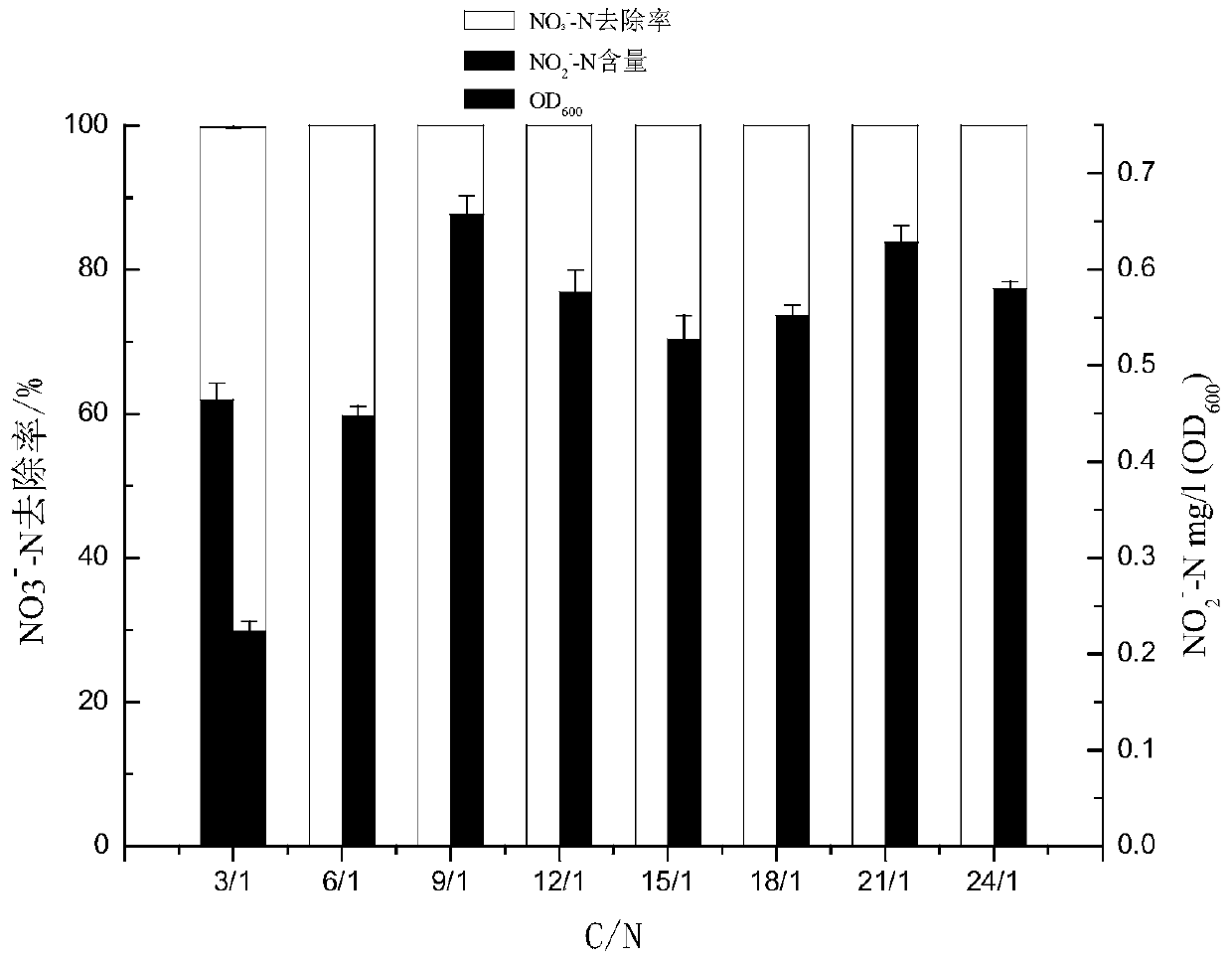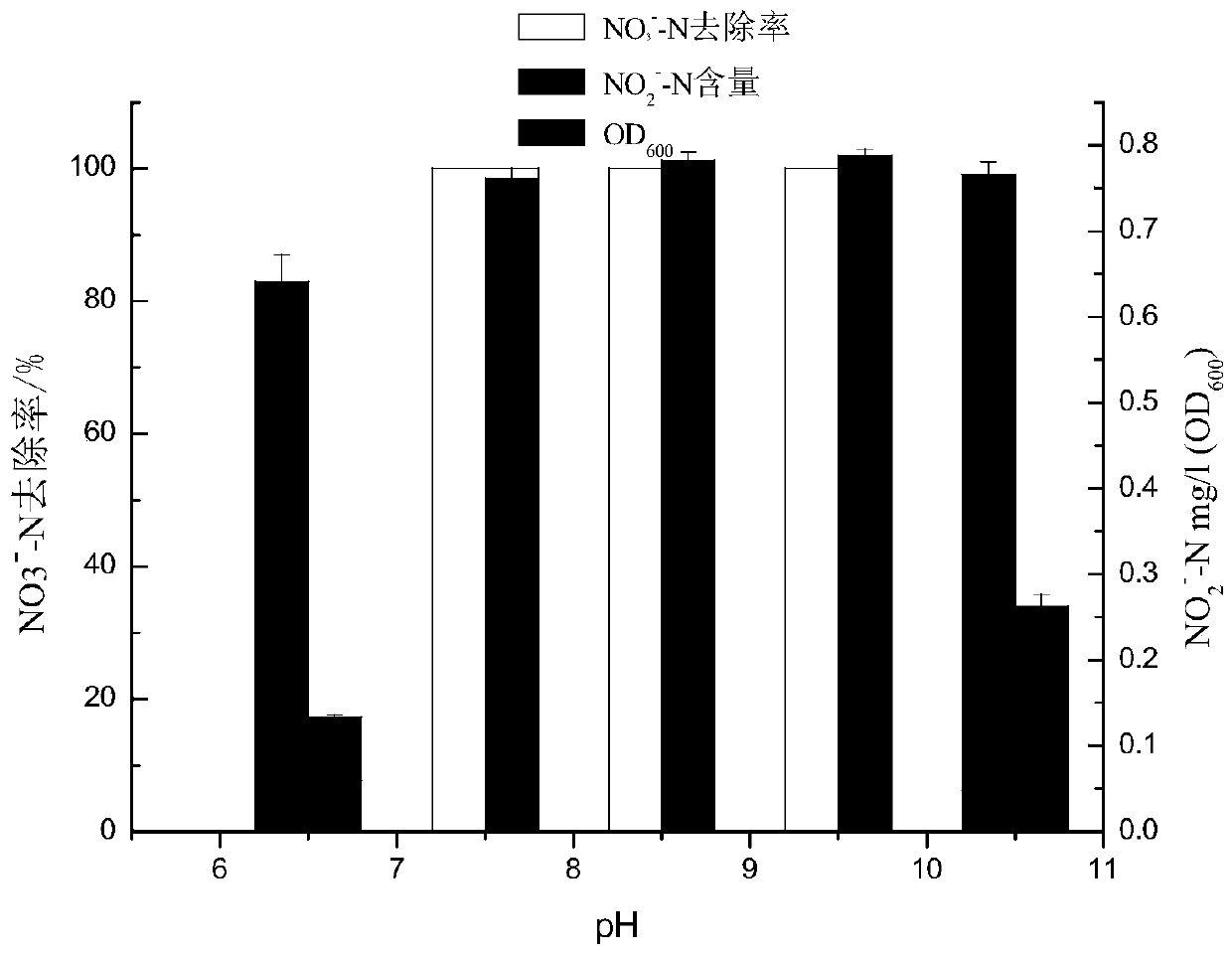A strain of Halomonas with denitrification ability and its application
A Halomonas, biological denitrification technology, applied in the direction of bacteria, microorganism-based methods, water/sludge/sewage treatment, etc., can solve the problem of few good strains and achieve strong tolerance and high denitrification efficiency High and carbon-saving effect
- Summary
- Abstract
- Description
- Claims
- Application Information
AI Technical Summary
Problems solved by technology
Method used
Image
Examples
Embodiment 1
[0042] Enrichment, isolation and identification of Example 1 Halomonas sp. (Halomonas sp.) CYQ1-6-1
[0043] 1 Enrichment and separation of bacterial strains: Take 10 g of the sludge sample from the primary sedimentation tank of Xiamen Qianpu Sewage Treatment Plant, add 90 ml of enrichment medium (sodium acetate 1 g / L, sodium citrate 2.5 g / L, NaCl 20 g / L, KH 2 PO 4 2g / L, Na 2 HPO 4 3g / L, MgSO 4 ·7H 2 O0.05g / L, FeSO 4 ·7H 2 O 0.02g / L, CaCl 2 0.02g / L, distilled water 1000mL, pH 7.6~8.2, sterilized at 121℃ for 20min), with 0.5g / L NO 2 - -N as the only nitrogen source, 28 ℃, 160rpm / min shaking culture, the first enrichment of aerobic denitrifying bacteria. After 15 days, take 10mL sample liquid from the initial enrichment culture medium, transfer it to fresh enrichment culture medium, and add 1.0g / L NO 2 - -N as the only nitrogen source, 28°C, 160rpm / min shaking culture, for the second enrichment. After 15 days, take 10mL sample solution from the secondary enrichment m...
Embodiment 2
[0050] Example 2 Optimization of Denitrification Conditions for Halomonas sp. CYQ1-6-1 in Simulated Wastewater
[0051] Scrape fresh bacteria from the MA plate, resuspend with sterile sea water, and adjust the bacterial concentration to 10 9 cfu / mL, according to the inoculation amount of 0.2% to inoculate to contain a certain concentration of NO 3 - -N or NO 2 - In the simulated wastewater of -N, the denitrification conditions of the strains were measured at different carbon sources, pH values, temperatures, salinities, and C / N ratios, and the denitrification conditions were optimized.
[0052] Simulated wastewater: KH 2 PO 4 2g / L, Na 2 HPO 4 3g / L, MgSO 4 ·7H 2 O 0.05g / L, FeSO 4 ·7H 2 O 0.02g / L, CaCl 2 0.02g / L, distilled water 1000mL, sterilized at 121℃ for 20min.
[0053] Experimental determination method: the determination of nitrate nitrogen is determined by the zinc cadmium reduction method of GB T12763;
[0054] 1. Effect of different carbon sources on the d...
Embodiment 3
[0059] Example 3 Denitrification effect of Halomonas sp. CYQ1-6-1 in simulated wastewater under optimal conditions
[0060] Pick a single colony of Halomonas sp. CYQ1-6-1 and streak it onto a Marine Agar solid plate, culture it at 28°C for 24 hours, take it out, scrape the fresh bacteria, and use nitrogen-free medium to make a bacterial suspension solution, the strain concentration was adjusted to 10 9 cfu / mL, according to the inoculation amount of 0.2% to inoculate with 100mg / L NO 3 - -N or NO 2 - -N is the only nitrogen source in simulated wastewater (sodium succinate 3.37g / L, NaCl 20g / L, KH 2 PO 4 2g / L, Na 2 HPO 4 3g / L, MgSO 4 ·7H 2 O 0.05g / L, FeSO 4 ·7H 2 O 0.02g / L, CaCl 2 0.02g / L, distilled water 1000mL, pH 7.6, sterilized at 121°C for 20min), cultivated in a shaker at 30°C, 160r / min, and sampled every 4h to detect the concentration of nitrite and nitrate in the wastewater, and the concentration of bacteria OD 600 . see results Figure 6-7 , the results sho...
PUM
| Property | Measurement | Unit |
|---|---|---|
| clearance rate | aaaaa | aaaaa |
Abstract
Description
Claims
Application Information
 Login to View More
Login to View More - R&D
- Intellectual Property
- Life Sciences
- Materials
- Tech Scout
- Unparalleled Data Quality
- Higher Quality Content
- 60% Fewer Hallucinations
Browse by: Latest US Patents, China's latest patents, Technical Efficacy Thesaurus, Application Domain, Technology Topic, Popular Technical Reports.
© 2025 PatSnap. All rights reserved.Legal|Privacy policy|Modern Slavery Act Transparency Statement|Sitemap|About US| Contact US: help@patsnap.com



